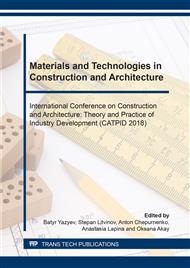[1]
B. A. Ashabokov, L. M. Fedchenko et al. Physics of city clouds and active influences on them: a state and directions of development, Nalchik, Printing house,, (2013).
Google Scholar
[2]
B. A. Ashabokov, at al. Physics of clouds and active influences on them, Nalchik, Printing house,, (2017).
Google Scholar
[3]
E. L. Kogan, I. P. Mazin, B. N. Sergeev, V. I. Khvorostyanov, Numerical simulation of clouds, Moscow, Gidrometeoizdat, (1984).
Google Scholar
[4]
Yu. A. Dovgalyuk, N. E. Veremei et al., The concept of the development of a numerical non-stationary three-dimensional model of the evolution of sedimentary convective cloud under natural conditions and under active effects, Proceedings of MGO, 282 (2016).
Google Scholar
[5]
J. Straka, Cloud and Precipitation Microphysics: Principles and Parameterizations. Cambridge, Cambridge University Press, (2009).
Google Scholar
[6]
V. I. Khvorostyanov, J. A. Curry, Thermodynamics, Kinetics, and Microphysics of Clouds. Cambridge University Press, (2014).
Google Scholar
[7]
B. A. Ashabokov, A.V. Shapovalov, D. D. Kuliev, K. A. Prodan, V. A. Shapovalov, Numerical modeling of the thermodynamic, microstructural and electrical characteristics of convective clouds at the stage of maximum growth and development, News of Higher educational institutions, Radiophysics. 56 (2013).
DOI: 10.1007/s11141-014-9483-z
Google Scholar
[8]
B. A. Ashabokov, L. M. Fedchenko, V. A. Shapovalov, A. G. Ezaova, Simulation Results the impact of the structure of the wind in the atmosphere on the processes formation of clouds, News KBSC Russian Academy of Sciences. 60 (2014) 21-28.
Google Scholar
[9]
B. A. Ashabokov, L. M. Fedchenko, V. A. Shapovalov, R. A. Shoranov, Numerical study of formation and growth of hail in the natural development of clouds and active influence, Russian Meteorology and hydrology. 1 (1994) 41-48.
Google Scholar
[10]
V. I. Bekryaev, M. V. Gurovict, Unsteady numerical model, Cb. Proc. Of MGO. 538 (1991) 109-121.
Google Scholar
[11]
L.K. Belova, A. S. Drofa, Research of influence of hygroscopic agents on the convective cloud from the results of numerical simulation, Proc. of MGO. Vol. 282 (2016) 184 – 201.
Google Scholar
[12]
N. E. Veremey, Yu. A. Dovgalyuk, V. N. Morozov, On the parameterization of microphysical processes of electrification in a three-phase model of a convective cloud, Meteorology and hydrology. 10 (2007) 42-54.
DOI: 10.3103/s1068373907100044
Google Scholar
[13]
S. A. Vladimirov, R. S. Pastushkov, A complex method of active effects on convective clouds in order to regulate precipitation. Three-dimensional numerical simulation, Proc. of MGO, 582 (2016) 116-127.
Google Scholar
[14]
A. S. Drofa, Investigation of the effect of hygroscopic particles on a warm convective cloud from the results of numerical modelling, News of RAS. Atmospheric and ocean physics. 46 (2010) 348-362.
DOI: 10.1134/s0001433810030060
Google Scholar
[15]
R. S. Pastushkov, Model of active effects on convective clouds by ice-forming aerosols. Current state and prospects of development, Proc. of MGO. 582 (2016) 128-157.
Google Scholar
[16]
T. Karacostas, V. Spiridonov, D. Bampzelis, I. Pytharoulis, I. Tegoulias, K. Tymbanidis, Analysis and numerical simulation of a real cell merger using a three-dimensional cloud resolving model, Atmospheric Research. 169 (2016) 547-555.
DOI: 10.1016/j.atmosres.2015.09.011
Google Scholar
[17]
L. S. Pontryagin, V. G. Boltyansky, R. V. Gamkrelidze, E. F. Mishchenko, Mathematical theory of optimal processes, Science, Moscow, (1976).
Google Scholar
[18]
N. N. Moiseev, Elements of the theory of optimal systems, Science, Moscow, (1975).
Google Scholar
[19]
B. A. Ashabokov, A. V. Shapovalov, Numerical model of the formation of hail cloud microstructure. News of Academy of Sciences, Atmospheric and ocean physics. 32 (1996) 364-369.
Google Scholar
[20]
A. G. Butkovsky Methods of control of systems with distributed parameters, Science, Moscow, (1975).
Google Scholar


